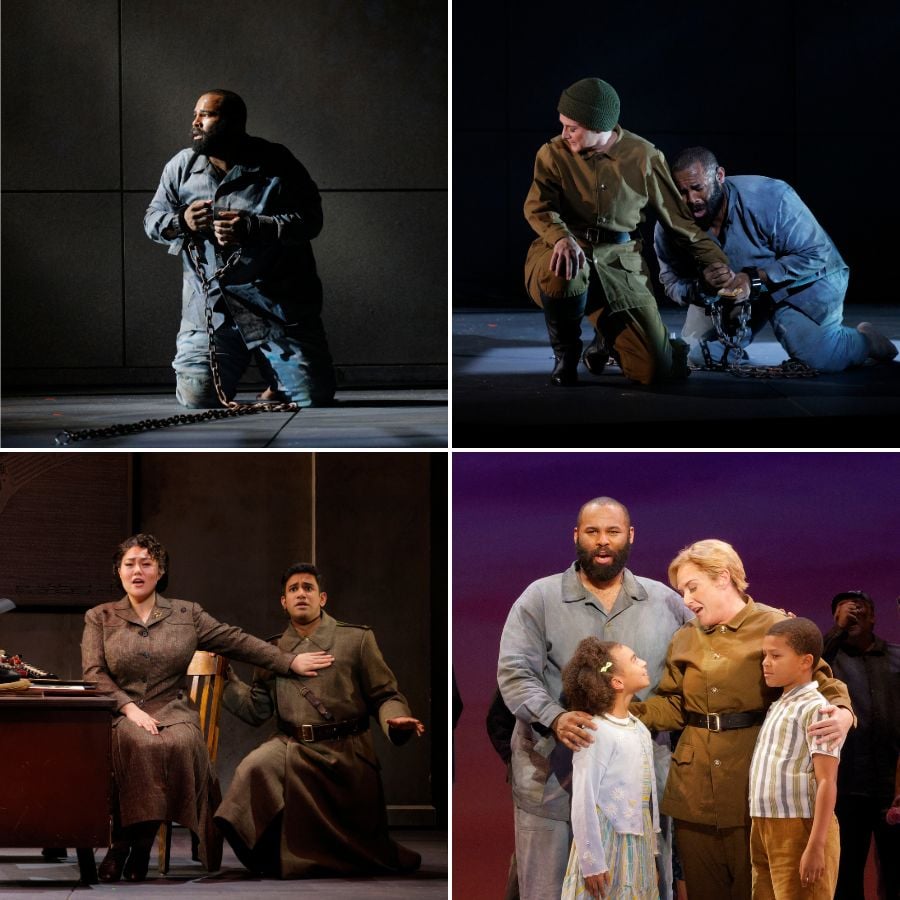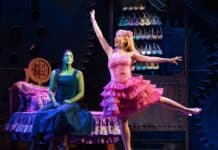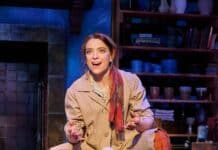The Washington National Opera’s production of Fidelio is a spectacular triumph. The credit for most of this triumph goes to director Francesca Zambello and conductor Robert Spano. Zambello uses Erhard Rom’s sets and the projections by S. Katy Tucker and Kylee Loera to concretize the trauma state experienced by a people living under the tortuous and sadistic rule of a brutal dictator. Throughout the show, her staging extravagantly and delightfully shifts perspectives from the intimate to the panoramic. The topical parallels this production draws between what is happening in the narrative of this work and what is happening in the United States of America today are both deft and poignant. Zambello has nurtured an atmosphere that has enabled both the already vocally top-notch cast and the physically committed and enthusiastic supernumeraries to give intelligent and fully inhabited dramatic performances of the text.

Fidelio is the pseudonym that the opera’s protagonist, Leonore, takes on when she disguises herself as a man. After perfecting her disguise, she seeks employment in the prison where her freedom-fighter husband Florestan is being kept under threat of execution. She intends to get Florestan out of jail or die trying. She succeeds in doing so with the help of the timely arrival of the Prime Minister, who announces that the dictator has been overthrown and Florestan, a political prisoner, is now freed.
The possibility of the United States becoming a dictatorship is something that the world is watching with incredulity and bated breath. This production acknowledges and embraces the current state of affairs in a way that informs and heightens what is in the libretto. The political and moral current situation has led many people within the United States itself to feel paralyzed with fear and despondent over the state that the country is in. While the U.S.’s situation is reflected in the opera, it seems to me that Zambello’s Fidelio focuses on presenting the audience with an alternative: a portrait of a nation of people who refuse to give in to despair despite their seemingly hopeless situation. The fact that Fidelio is filled with melodies that you can tap your foot to seems to me to underscore this paradox. A pointed and topical embodiment of this paradox that comes in the form of Denyce Graves’ arrival as the Prime Minister (in what could be called Hope 2.0, American style) seems to further underscore this production’s exhortation to refuse despair.
There are four moments in the opera that I was especially moved by.
The quartet “Mir ist so wunderbar” (sung by Sinéad Campbell Wallace, David Leigh, Tiffany Choe, and Sahel Salam) is a slow waltz in a major key in which the characters speak their inner thoughts. It’s just so pretty. It’s sung by people who, though they may be scared or frustrated, are hoping to have a future.
At Leonore’s urging some of the prisoners are allowed to go out in the sunlight. The chorus that the prisoners sing as they rise from the darkness of the prison into the sun exudes a sensual gratitude. Experiencing this moment, I was reminded of something I once read but I can’t now recall the source: “Give me light. Even if it is but light to die in.”

In his (long-awaited) first appearance at the opening of the second act, Florestan, rather than engaging in resentful bravado or even blame, humbly accepts, without regrets, the reality of the consequences of choosing to fight for justice. He accepts his lot as the will of God. Tenor Jamez McCorckle delivers the first part of this aria lying prone on the floor and the rest of it lifting himself, in quite heavy-appearing (and sounding) chains, from the floor. It’s thrilling to listen to and watch. However, do not try this at home.
When the Prime Minister arrives to announce the overthrow of the dictator, the town erupts in an ecstatic celebration that looks and feels like a Norman Rockwell drawing that has been brought to life and is being performed by dancers on steroids. During this whirlwind of celebration, reunions, the giving of flowers, and the official recognitions of service take place at a normal pace. The contrast is exhilarating to watch. And most exhilarating of all to watch in this enactment — as though it contains a hint for the audience — is the enthusiastic participation of a little boy who leads the entire populace in a parade around the town while hoisting a white banner aloft and running across, behind, through, and around the proceedings. Such irrepressible hope. Such irrepressible joy.
Running Time: Approximately one hour and 53 minutes, plus a 25-minute intermission.
Fidelio plays through November 4, 2024, presented by the Washington National Opera performing in the Opera House at the Kennedy Center, 2700 F St NW, Washington, DC. Tickets ($29–$269) can be purchased at the box office, online, or by calling (202) 467-4600 or toll-free at (800) 444-1324. Box office hours are Monday-Saturday, 10 am-9 pm, and Sunday 12pm-9 pm.
The program for Fidelio is online.
COVID Safety: Masks are optional in all Kennedy Center spaces for visitors and staff. If you prefer to wear a mask, you are welcome to do so. See Kennedy Center’s complete COVID Safety Plan here.
Fidelio
By Ludwig van Beethoven
Produced by Washington National Opera
Directed by Francesca Zambello
Conductor: Robert Spano
CAST
Sinéad Campbell Wallace: Leonore
Jamez McCorkle: Florestan
Derek Welton: Pizarro
David Leigh: Rocco
Tiffany Choe: Marzelline
Jaquino: Sahel Salam
Prime Minister: Denyce Graves
1st Prisoner: Chaz’men Williams-Alli
2nd Prisoner/Prime Minister’s Assistant: Jim Williams
CREATIVE TEAM
Set Designer: Erhard Rom
Costume Designer: Anita Yavich
Lighting Designer: Jane Cox
Projection Designer: S. Katy Tucker
Co-Projection Designer: Kylee Loera
Dramaturg: Kelley Rourke
Fight Master: Case Kaleba
Chorus Master: Steven Gathman
Assistant Director: Amy Hutchison



